How to Set Up a Referral Program on Shopify? (With Excel Checklist)
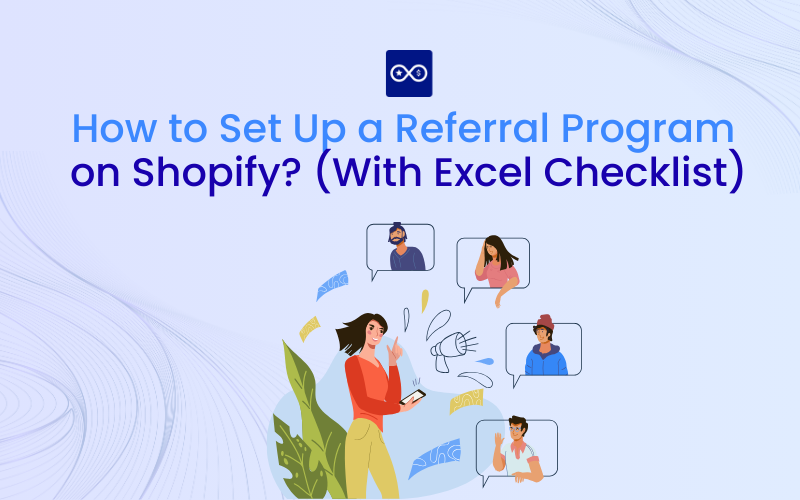
Looking to harness the power of word-of-mouth marketing for your Shopify store? Setting up a referral program is one of the most effective ways to turn your satisfied customers into brand advocates who bring in new buyers. In fact, referred customers have a 37% higher retention rate and generate 25% more profit than non-referred customers, according to Wharton School research.
Learning how to set up a referral program on Shopify might seem complex, but with the right approach and tools, you can launch a successful program that drives sustainable growth. This comprehensive guide will walk you through everything you need to know, complete with an Excel checklist to keep your implementation on track.
Whether you’re a new Shopify store owner or looking to optimize your existing marketing efforts, this guide provides the blueprint for creating a referral program that converts browsers into buyers and customers into advocates.
What Is a Shopify Referral Program and Why Should You Use One?
A Shopify referral program is a structured marketing strategy that incentivizes your existing customers to recommend your products to their friends, family, and social networks in exchange for rewards. It’s a systematic approach to word-of-mouth marketing that leverages customer satisfaction to drive new acquisitions.
The concept is simple yet powerful: happy customers share your brand with people they trust, creating a cycle of organic growth that’s both cost-effective and highly converting.
How Referral Programs Work on Shopify?
The referral process on Shopify follows a straightforward workflow:
- Customer enrollment: Existing customers sign up for your referral program through your store or a dedicated app
- Unique link/code generation: Each participant receives a personalized referral code or trackable link
- Sharing: Customers share their referral links via email, social media, or direct messaging
- Tracking: The referral app monitors clicks, conversions, and purchases from shared links
- Reward distribution: Both referrer and referee receive predetermined rewards when conditions are met
- Analytics: Store owners track program performance through dashboards and reports
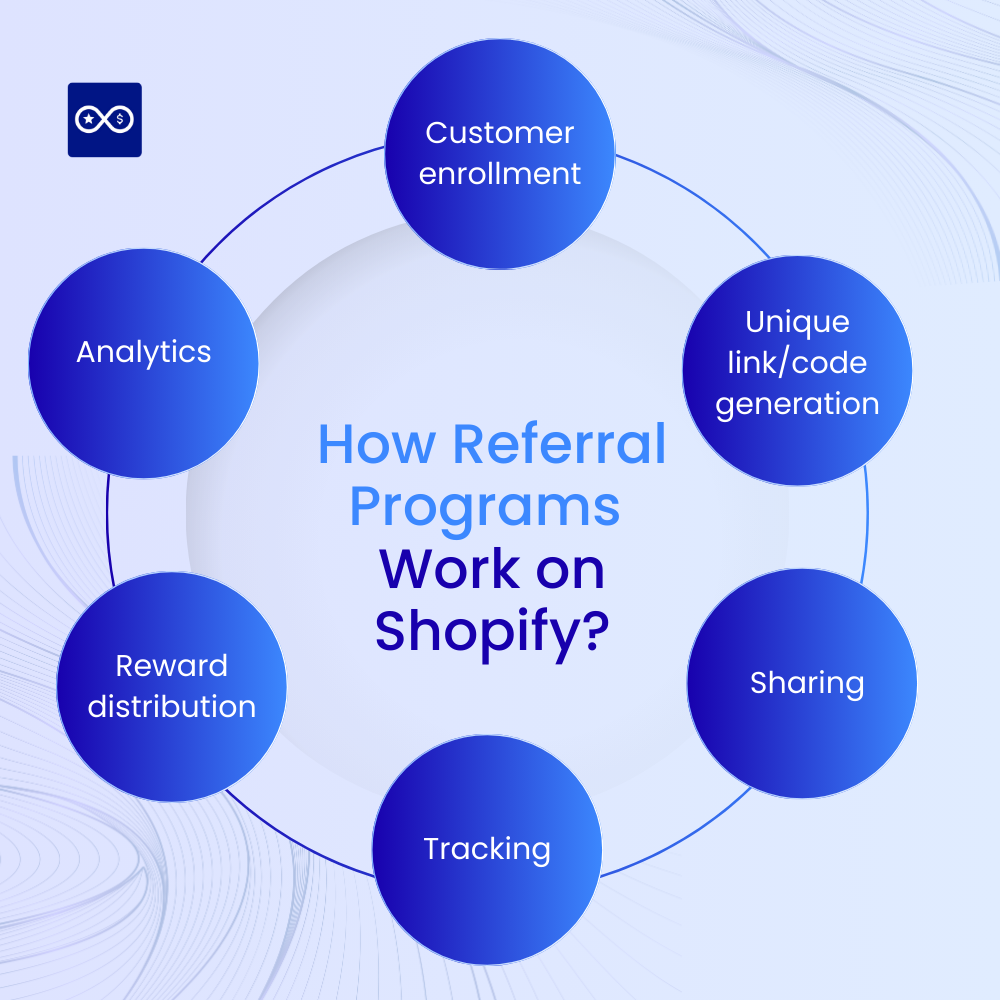
Benefits of Referral Marketing Over Traditional Marketing
Referral programs consistently outperform traditional marketing channels across key metrics:
| Metric | Referral Programs | Traditional Advertising |
| Conversion Rate | 3–5x higher | Baseline |
| Customer Acquisition Cost | 50–75% lower | Higher upfront costs |
| Customer Lifetime Value | 25% higher | Standard LTV |
| Trust Factor | 92% trust recommendations | 47% trust ads |
Key Advantages:
- Higher conversion rates: Referred customers convert 2–3x more than other channels
- Lower acquisition costs: Word-of-mouth costs significantly less than paid advertising
- Increased customer loyalty: Both referrers and referees show higher retention rates
- Enhanced brand credibility: Personal recommendations carry more weight than traditional ads
- Scalable growth: Programs compound as your customer base expands
Prerequisites Before You Start
Before diving into how to set up a referral program, ensure your Shopify store meets these essential requirements for program success:
Foundation requirements:
- Established customer base with positive feedback
- Stable product-market fit with satisfied buyers
- Clear brand positioning and value proposition
- Basic email marketing infrastructure in place
- Customer service processes that handle inquiries efficiently
Identify Your Ideal Referral Customer
Your most successful referrers share specific characteristics that you can identify through data analysis:
High-value referrer profiles typically include:
- Net Promoter Score (NPS) of 9-10: These customers actively promote your brand
- Multiple purchases: Repeat buyers demonstrate product satisfaction and brand loyalty
- High Customer Lifetime Value (CLV): Customers who spend more tend to refer higher-value prospects
- Active social media presence: Users who regularly share content are natural advocates
- Recent positive reviews: Customers who’ve left 4-5 star reviews show satisfaction
How to find these customers using Shopify Analytics:
- Navigate to Analytics > Reports > Customer reports
- Filter for repeat customers with orders 30+ days apart
- Identify top 20% of customers by total spending
- Cross-reference with customer service interactions (positive feedback)
- Review email engagement rates from marketing campaigns
Analyze Existing Referral and Traffic Sources
Understanding your current referral patterns helps optimize your formal program:
Using Shopify Analytics
- Go to Analytics > Reports > Acquisition reports
- Review “Traffic by social referrer” to identify organic sharing
- Check “Referral traffic” for external sites driving visitors
- Analyze “Customer acquisition” reports for growth patterns
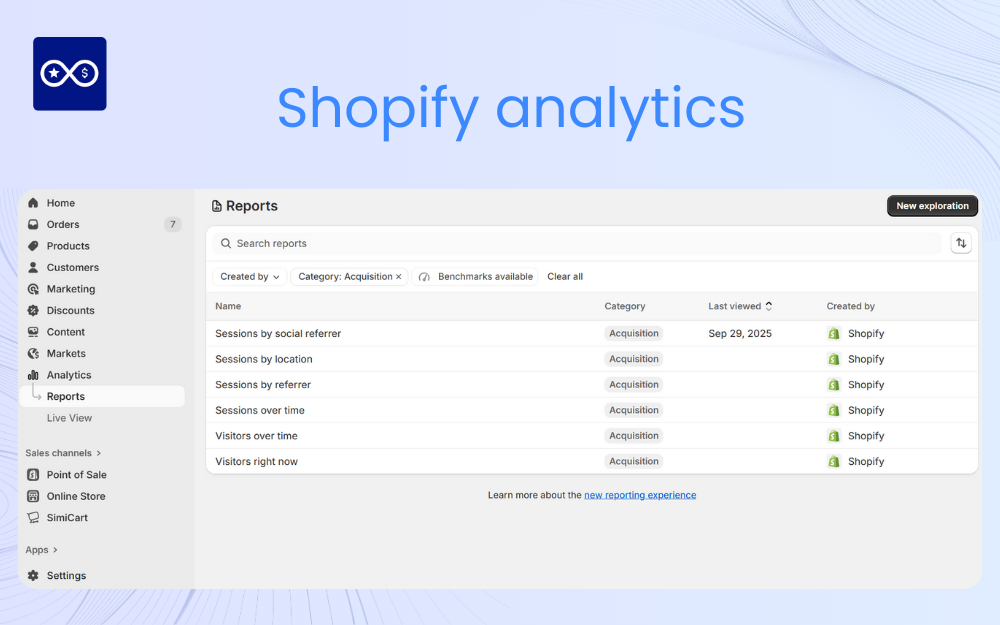
Using Google Analytics
- Set up “Acquisition > All Traffic > Referrals” tracking
- Monitor social media traffic sources
- Track direct traffic spikes (often indicating word-of-mouth)
Customer surveys provide additional insights
- Add “How did you hear about us?” to post-purchase emails
- Include referral questions in customer satisfaction surveys
- Use exit-intent popups to gather acquisition data
Planning Your Referral Program (with Excel Checklist)
Strategic planning ensures your referral program aligns with business objectives and customer expectations. Use this comprehensive checklist to organize your implementation process. You can copy the table below directly into Excel or Google Sheets to track your progress:
1. Set Goals and KPIs
Successful referral programs require clear, measurable objectives. Define SMART goals (Specific, Measurable, Achievable, Relevant, Time-bound) that align with your overall business strategy.
Common referral program goals:
- Customer acquisition: Increase new customers by 25% in Q1
- Revenue growth: Generate $50,000 in referred revenue within 6 months
- Cost efficiency: Reduce customer acquisition cost by 40%
- Brand awareness: Expand reach to 10,000 new potential customers
- Customer loyalty: Increase repeat purchase rate among participants by 15%
Essential KPIs to track:
- Referral rate (% of customers who make referrals)
- Conversion rate of referred traffic
- Average order value of referred customers
- Customer acquisition cost through referrals
- Program ROI and payback period
Here’s a polished, reformatted version of your Program Structure Decisions section that keeps the content intact but adds flow and readability:
2. Program Structure Decisions
Designing the right structure is critical to balancing costs with customer motivation. You’ll need to decide whether a one-sided or two-sided reward system fits your goals best:
| Structure Type | Best For | Pros | Cons |
| One-sided | High-margin products | Lower costs, simpler tracking | May reduce sharing motivation |
| Two-sided | Customer acquisition focus | Higher participation, faster growth | Higher costs, more complex tracking |
Reward Options to Consider:
- Percentage discounts: 10–20% off the next purchase
- Fixed dollar amounts: $10–25 store credits
- Free shipping: Especially effective for lower AOV stores
- Tiered rewards: Unlock bigger rewards for multiple referrals
- Product gifts: Free items for high-value referrals
3. Map Your Customer Communication Channels
Identify all touchpoints where you can promote your referral program:
Primary channels:
- Post-purchase email sequences
- Order confirmation pages
- Customer account dashboards
- Website footer and navigation
Secondary channels:
- Social media profiles and posts
- Newsletter mentions
- Customer service interactions
- Package inserts and thank-you notes
4. Choose Your Rewards
Research indicates optimal reward values vary by industry and average order value:
General guidelines:
- Reward value should be 10-25% of average order value
- Two-sided programs typically offer equal rewards to both parties
- Consider your profit margins when setting reward amounts
- Test different reward types to find what motivates your customers
Excel Referral Program Planning Checklist
Copy this table into Excel or Google Sheets to stay organized while setting up and running your referral program system:
| Step | Owner | Notes |
| Define ideal referrer persona | Marketing | Use NPS, LTV data, and prior referral patterns |
| Set clear program goals/KPIs | Marketing | Track revenue, CAC, conversion rate |
| Decide on reward mechanics | Marketing | Choose one/two-sided, set value, add tiers |
| Draft referral program FAQ | Marketing | Cover eligibility, payout process, T&Cs |
| Prepare customer comms channels | Marketing | Email flows, on-site messages, post-purchase prompts |
| Outline fraud prevention steps | Tech | Block self-referrals, bots, duplicate accounts |
| Set tracking/analytics plan | Tech | UTM codes, dashboard setup, Excel/Sheet logs |
| Assign program ownership | Ops | Define who manages and tracks referrals |
| Prepare compliance/disclaimers | Legal | GDPR requirements, local laws, T&Cs |
| Install Shopify referral app | Tech | Examples: Bloop, Yotpo, ReferralCandy |
| Test referral funnel end-to-end | QA | Walk through both referrer and referee journeys |
| Schedule launch and first promo | Marketing | Plan email/send timing, site pop-ups |
| Ongoing review and iteration | Marketing | Weekly/monthly analytics check-ins |
Instructions: Copy this table into Excel and customize the “Notes” column for your specific needs. Update the “Complete” column as you finish each step.
Step-by-Step: How to create a referral program for Shopify stores
Now that you’ve planned your program, let’s walk through the technical implementation process for how to set up a referral program on Shopify.
1. Install and Configure a Shopify Referral App
Shopify’s App Store offers several high-quality referral solutions. Here are the top options:
Leading Shopify referral apps:
- Bloop: The easiest and most affordable referral and affiliate platform with advanced referral widgets
- ReferralCandy: User-friendly interface with strong analytics
- Friendbuy: Advanced fraud prevention and customization options
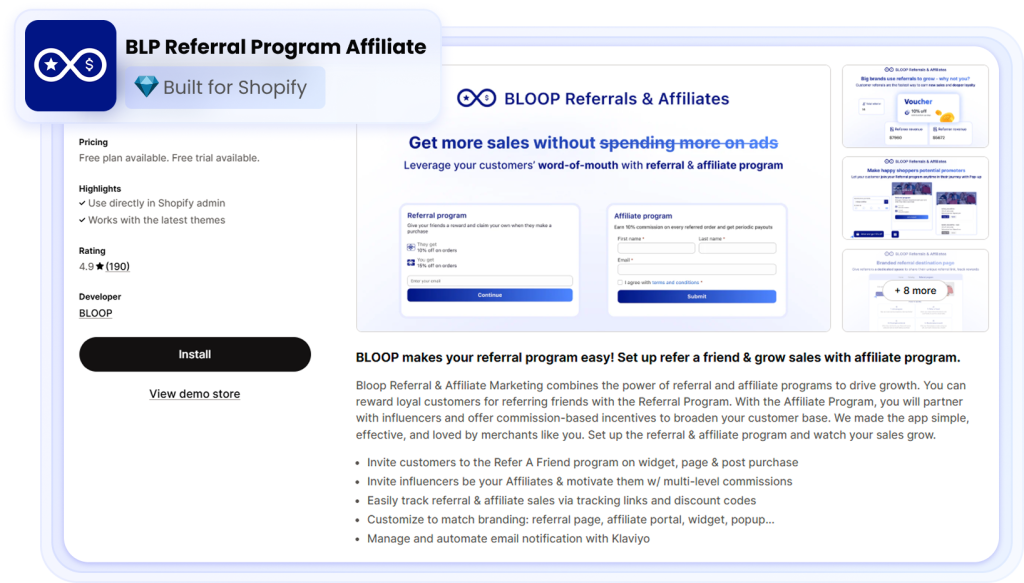
Installation process:
- Sign up for Shopify with the Shopify $1 trial deal
- Visit your Shopify Admin > Apps section
- Browse the App Store or search “referral program”
- Read reviews and compare features
- Click “Add app” for your chosen solution
- Follow the installation prompts and grant necessary permissions
- Complete initial setup wizard
Pro tip: Most apps offer free trials. Test 2-3 options to find the best fit for your needs and budget.
2. Customize Branding and Rewards
Ensure your referral program feels like a natural extension of your brand:
Branding elements to customize:
- Upload your logo and brand colors
- Write compelling call-to-action copy
- Design email templates for referral invitations
- Create landing pages that match your store’s aesthetic
- Set up social sharing messages with your brand voice
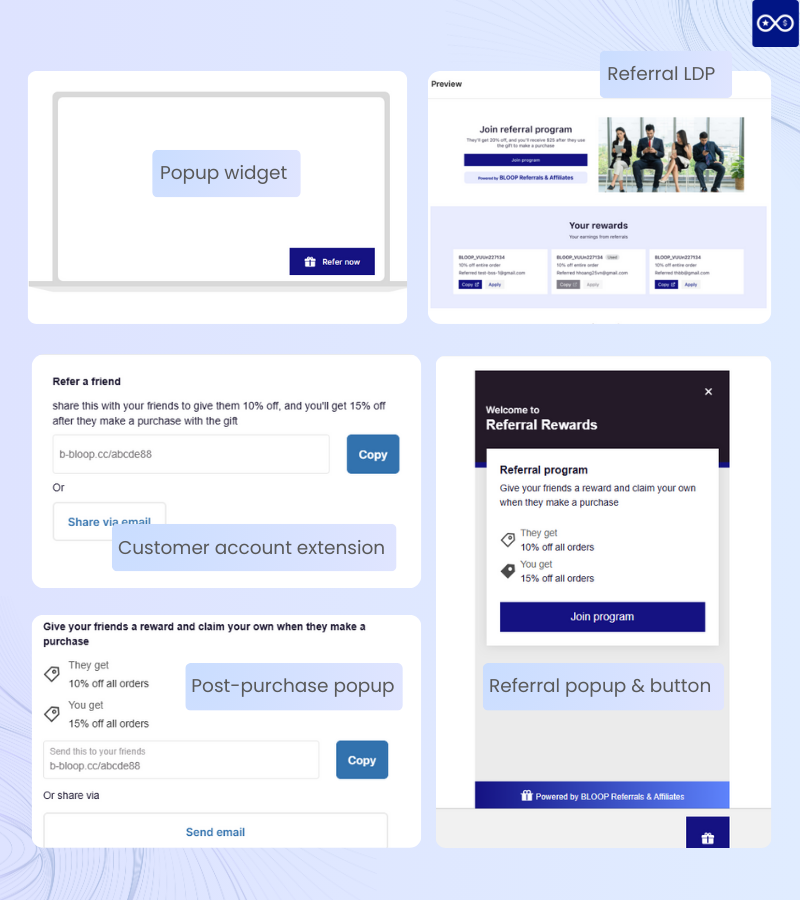
Reward configuration:
- Input your chosen reward values and types
- Set minimum order requirements if applicable
- Configure reward expiration dates
- Test reward delivery mechanisms
- Create terms and conditions for program participation

3. Define and Set Program Rules
Establish clear guidelines to prevent fraud and ensure smooth operations:
Eligibility requirements:
- Minimum purchase amount for referrers
- Geographic restrictions if applicable
- Customer account age requirements
- Product category inclusions/exclusions
Fraud prevention measures:
- IP address tracking to prevent self-referrals
- Email verification for new customers
- Manual review for high-value rewards
- Limits on referrals per customer per time period
Integration setup:
- Connect with your email marketing platform (Klaviyo, Mailchimp)
- Set up webhook notifications for new referrals
- Configure customer service tools for support inquiries
4. Launch and Promote Your Program
Multi-channel promotion maximizes program awareness and participation:
Launch sequence:
- Send announcement email to existing customers
- Add program promotion to your website header
- Create dedicated landing page with program details
- Update social media bios and create announcement posts
Ongoing promotion strategies:
- Include referral CTAs in order confirmation emails
- Add program widgets to customer account pages
- Mention referrals in customer service interactions
- Create social proof content featuring successful referrers
Example email copy:
“Love [Brand Name]? Share the love and earn rewards! For every friend who makes a purchase using your unique link, you’ll both receive [reward amount]. It’s our way of saying thanks for spreading the word about products you already enjoy.”
5. Track Performance and Iterate
Regular monitoring and optimization ensure long-term program success:
Key metrics to monitor:
- Referral participation rate: % of customers who make referrals
- Conversion rate: % of referred visitors who purchase
- Average order value: Spending patterns of referred customers
- Program ROI: Revenue generated vs. rewards paid out
- Customer satisfaction: Feedback on program experience
Optimization opportunities:
- A/B test different reward amounts
- Experiment with reward types (discounts vs. store credit)
- Optimize referral email templates for higher open rates
- Adjust program messaging and positioning
- Streamline the referral sharing process
Advanced Tactics to Maximize Referral Performance
Once your basic referral program is running, implement these advanced strategies to boost participation and results.
Automate Referral Nudges and Follow-Up
Strategic automation increases program engagement without manual effort:
Post-purchase automation:
- Send referral invitations 7-14 days after delivery
- Include referral links in review request emails
- Add program reminders to reorder campaigns
- Segment high-satisfaction customers for targeted outreach
Follow-up sequences:
- Remind customers about unused referral rewards
- Celebrate referral milestones with bonus rewards
- Re-engage dormant participants with special offers
- Thank successful referrers with exclusive content
Use Milestone, Gamified, and Leaderboard Campaigns
Adding a sense of competition and achievement can make referral programs more engaging and fun for customers.
| Campaign Type | How It Works | Best For |
| Milestone | Rewards grow as customers hit referral milestones (e.g., 1, 3, 5 referrals) | Motivating multiple referrals |
| Leaderboard | Ranks top referrers publicly to spark competition | Driving high-volume referrals |
| Gamified | Uses points, badges, or levels for achievements | Appealing to younger or tech-savvy audiences |
Implementation tips:
- Announce new campaigns through email and social channels to maximize visibility
- Share real-time progress updates to keep participants motivated
- Offer exclusive prizes or bonuses for top performers
- Run seasonal challenges tied to holidays, sales events, or product launches
Encourage Social and UGC Shares
Amplify your program through social media and user-generated content:
Social integration strategies:
- Offer bonus rewards for social media shares
- Create Instagram-worthy unboxing experiences with referral cards
- Encourage video testimonials with additional incentives
- Enable easy sharing to multiple social platforms
UGC amplification:
- Reward customers who tag friends in social posts
- Create hashtag campaigns that include referral messaging
- Feature customer photos and stories on your social accounts
- Partner with micro-influencers who are existing customers
Build a Referral FAQ and Troubleshooting Resource
Address common questions to reduce friction and support inquiries:
Essential FAQ topics:
- How referral tracking works
- When rewards are delivered
- Troubleshooting missing rewards
- Program terms and conditions
- Contact information for support
Automated support templates:
- “Your referral reward is processing” messages
- “Friend hasn’t received their discount” explanations
- “How to share your referral link” tutorials
- “Reward expiration reminder” notifications
Bloop also has an extremely detailed article on how to effectively promote a referral program for Shopify store, refer to it now for more ideas for your referral campaign!
Shopify Referral Program Case Studies
Rothy’s
At Rothy’s, every successful referral earns $20 for both the referrer and the friend (with a $50 minimum purchase). This accessible incentive encourages broad participation and has played a key role in revenue growth. Referrals are said to contribute up to 18%. What makes it even more powerful is Rothy’s cult-like following; for many fans, sharing their favorite shoes isn’t just about saving money, it’s about being part of something bigger.

MeUndies
MeUndies cleverly paired its referral program with a membership model, offering $20 in store credit to referrers and 20% off the first order for referees. By nurturing a strong sense of community, the brand makes sharing feel like a natural extension of being part of MeUndies. With referral software simplifying the process, they’ve shown how community power can be the real engine behind brand growth.

LIVELY
LIVELY weaves referrals right into its rewards program, where customers earn one point for every dollar spent. On top of that, both referrers and their friends get 15% off when a referral turns into a purchase. The results were immediate: within just 48 hours of launching, the brand collected 133,000 emails and drew 300,000 online sessions. By blending loyalty perks with referrals, LIVELY created a program that not only encouraged sharing but also generated massive early momentum.
FAQs about Shopify Referral Programs
Most basic referral programs can be set up in 2-4 hours using apps like Bloop or ReferralCandy. However, allow 1-2 weeks for complete planning, testing, and optimization.
App costs typically range from $20-200+ per month depending on features and transaction volume. Factor in reward costs (usually 5-15% of referred revenue) and setup time.
Implement IP tracking, email verification, manual review for high-value rewards, and set reasonable limits on referrals per customer. Quality referral apps include built-in fraud prevention.
Yes, most referral apps integrate with popular email marketing, loyalty, and analytics tools. Check compatibility before choosing your app.
Industry averages range from 2-5% for referral program participation and 15-30% conversion rates for referred traffic. These vary significantly by industry and implementation quality.
Ensure your app provider is GDPR compliant, include clear opt-in language, allow easy unsubscribing, and maintain transparent data usage policies.
>> Ready to get started? Copy the Excel checklist provided in this guide to track your implementation progress. You can also adapt it for Google Sheets or other project management tools.
Conclusion
Buiding a referral program on Shopify is one of the most cost-effective ways to drive sustainable growth for your e-commerce business. By following this comprehensive guide on how to set up a referral rewards program and using the provided Excel checklist, you’ll have a clear roadmap from initial planning through advanced optimization.
Remember, successful referral programs combine the right technology with genuine customer satisfaction. Focus on delivering exceptional products and experiences, and your customers will naturally want to share your brand with others.
The key to learning how to set up a referral program effectively lies in careful planning, consistent execution, and ongoing optimization. Start with the basics, measure your results, and continuously refine your approach based on customer feedback and performance data.
Ready to launch your Shopify referral program? Try Bloop’s referral and loyalty platform free for 14 days and see how easy it can be to turn your customers into your best marketers. With advanced automation, fraud prevention, and seamless Shopify integration, Bloop makes referral marketing simple and profitable.